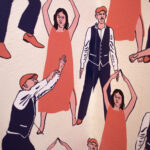Above the Sounds of Ideologies Clashing

The wallpaper in my childhood bathroom has been one of my greatest artistic influences. Besides Mad Magazine and Captain America comic books, it was this incredible wallpaper – a beautifully rendered circus scene, complete with lion tamers, acrobats and clowns, complemented by a fantastic early ‘70s color palette of green, blue, fuchsia, ochre, and purple and arranged in a mind-boggling complex repeat pattern – that inspired me. Throughout my artistic development, I often refer back to this design in my work – its stylistic linework, the narrative, and the color palette. Exploring surface design as an artistic platform was an inevitable progression.
As I experimented with and explored repeat patterns I began considering the metaphoric possibilities of wallpaper. In this narrative form of surface design – commonly referred to as conversational style – the story elements never progress, they are snippets of time, frozen in endless unyielding repetition. For me this makes a curious analogy. By utilizing a motif that explores a concept or situation that never resolves, it creates a compelling commentary about history repeating itself or about how the more things change the more things stay the same. This possibility prompted me to consider not limiting the story to a handful of repeated components but to expand the narrative and turn an entire room into a repeat; that there could be a lot more to the story but it will eventually come back to the beginning. These loops and cycles can then expand the analogy and be used to represent culture, politics, election years and the waxing and waning of political and personal ideologies. In this installation the rhythms of ideological conflict – the staking out of territories, the assertions, enticements, and grandstanding, the arguments and counter-arguments, the agreements, divisions and ultimately homeostasis – forms the design components that cycle throughout the room.

In my childhood bathroom the wallpaper was intended to serve as the backdrop despite how bold it was. It existed to fill in space, add color and texture and endlessly fascinate anyone enjoying their periodic repose. With this installation, however, the background becomes the foreground, forcing the conversation into the middle of the room. And this conversation, at this particular place and time, is one we cannot afford to ignore.











